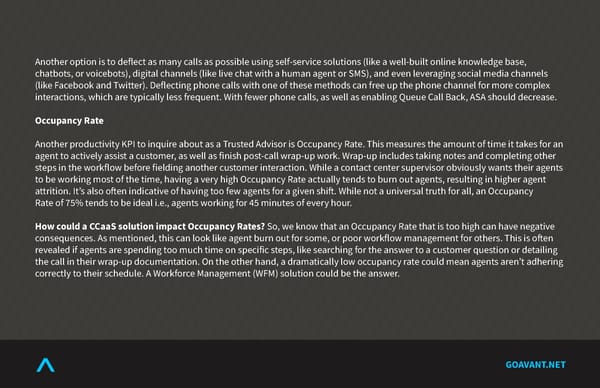Another option is to deflect as many calls as possible using self-service solutions (like a well-built online knowledge base, chatbots, or voicebots), digital channels (like live chat with a human agent or SMS), and even leveraging social media channels (like Facebook and Twitter). Deflecting phone calls with one of these methods can free up the phone channel for more complex interactions, which are typically less frequent. With fewer phone calls, as well as enabling Queue Call Back, ASA should decrease. Occupancy Rate Another productivity KPI to inquire about as a Trusted Advisor is Occupancy Rate. This measures the amount of time it takes for an agent to actively assist a customer, as well as finish post-call wrap-up work. Wrap-up includes taking notes and completing other steps in the workflow before fielding another customer interaction. While a contact center supervisor obviously wants their agents to be working most of the time, having a very high Occupancy Rate actually tends to burn out agents, resulting in higher agent attrition. It’s also often indicative of having too few agents for a given shift. While not a universal truth for all, an Occupancy Rate of 75% tends to be ideal i.e., agents working for 45 minutes of every hour. How could a CCaaS solution impact Occupancy Rates? So, we know that an Occupancy Rate that is too high can have negative consequences. As mentioned, this can look like agent burn out for some, or poor workflow management for others. This is often revealed if agents are spending too much time on specific steps, like searching for the answer to a customer question or detailing the call in their wrap-up documentation. On the other hand, a dramatically low occupancy rate could mean agents aren’t adhering correctly to their schedule. A Workforce Management (WFM) solution could be the answer. GOAVANT.NET
 CCaaS E Book Page 6 Page 8
CCaaS E Book Page 6 Page 8